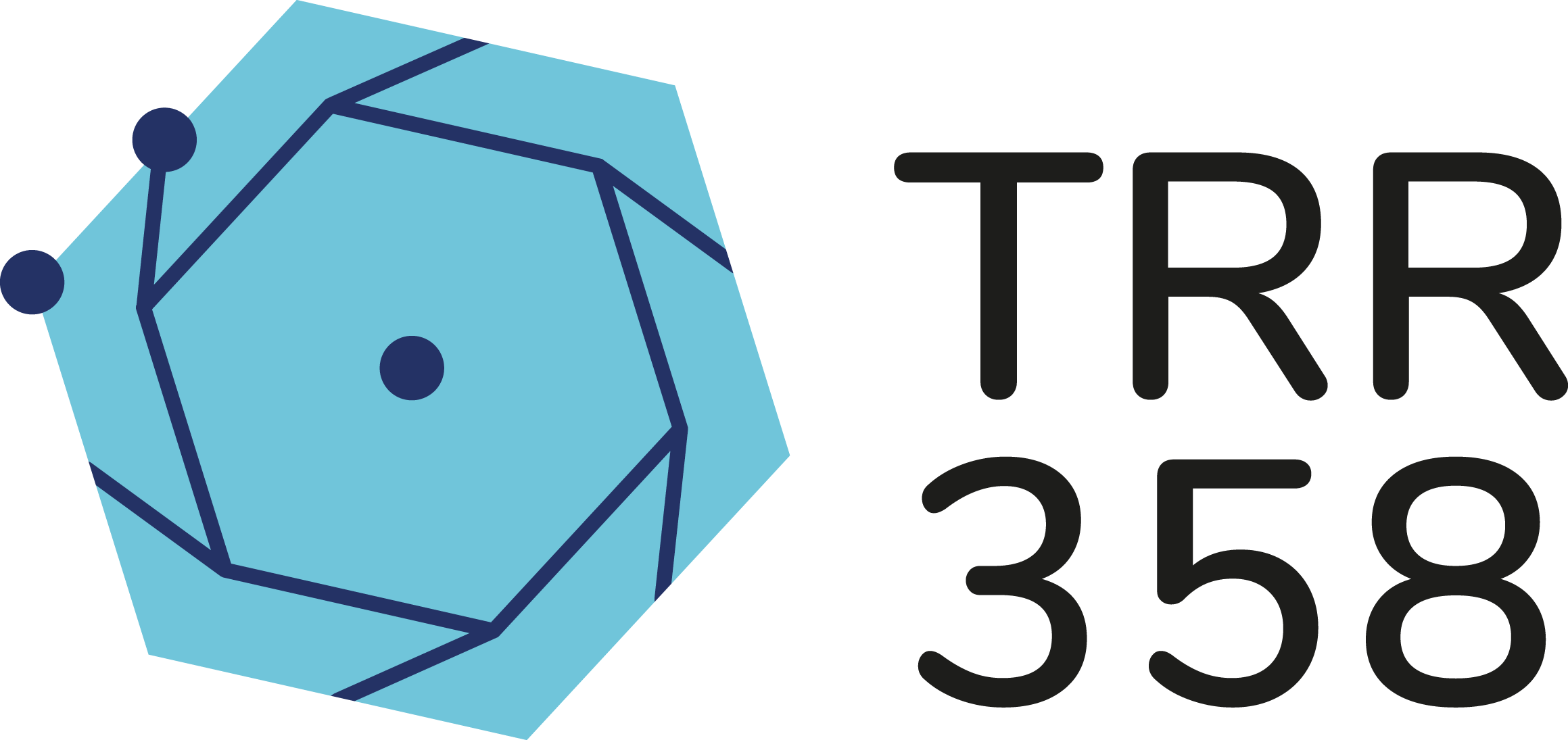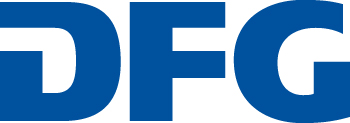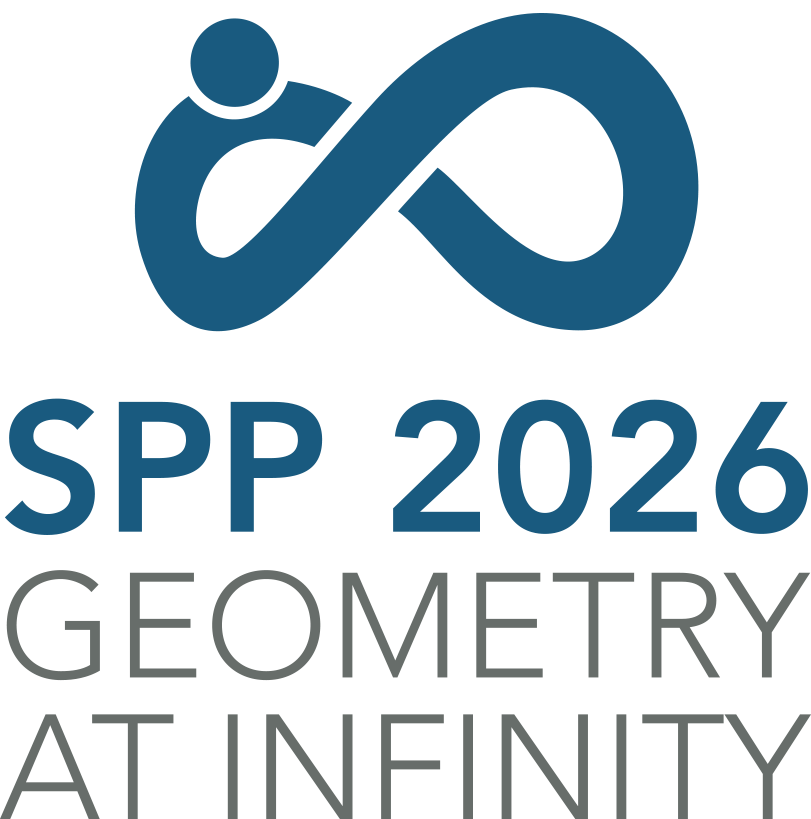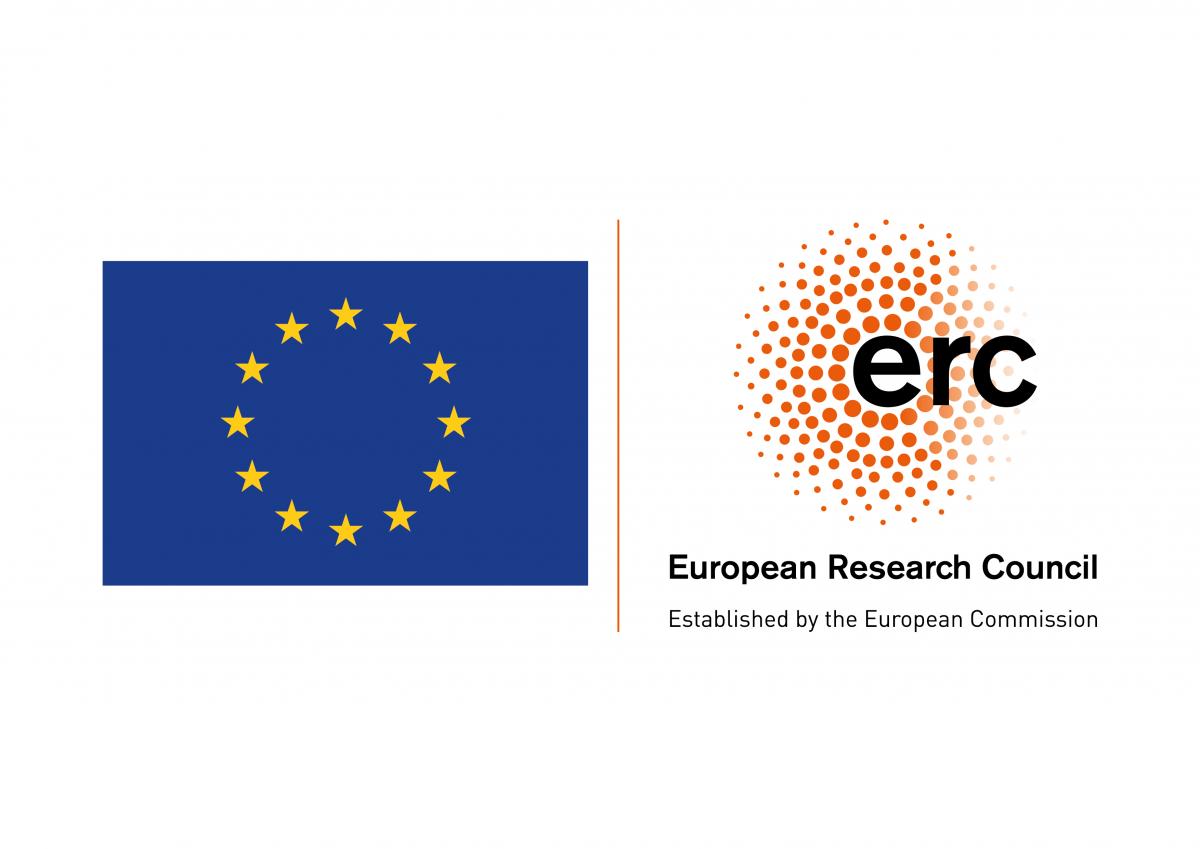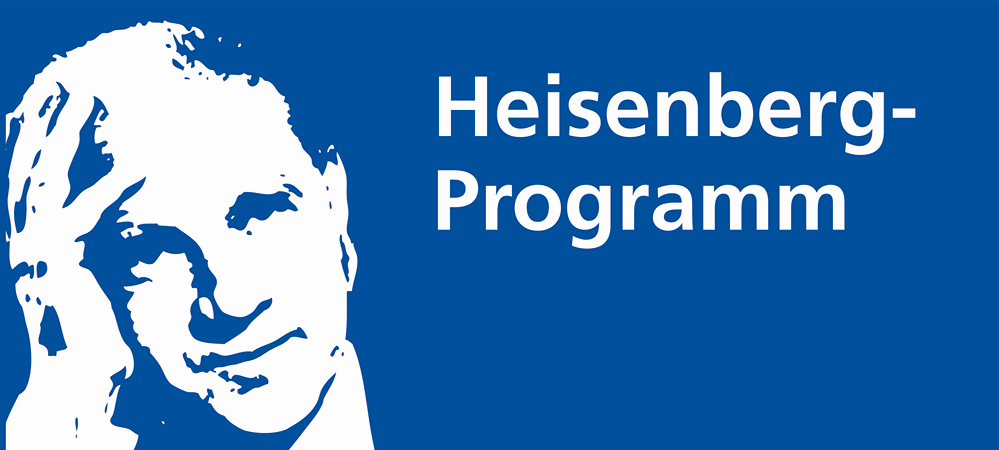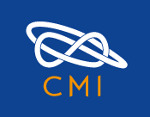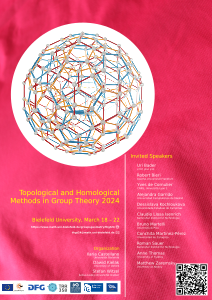
This is the fourth instalment of the THGT conference series. As its predecessors, the conference takes place in Bielefeld in spring, and as before it welcomes researchers studying groups through their interactions with topology and homology, as well as people interested in entering the subject.
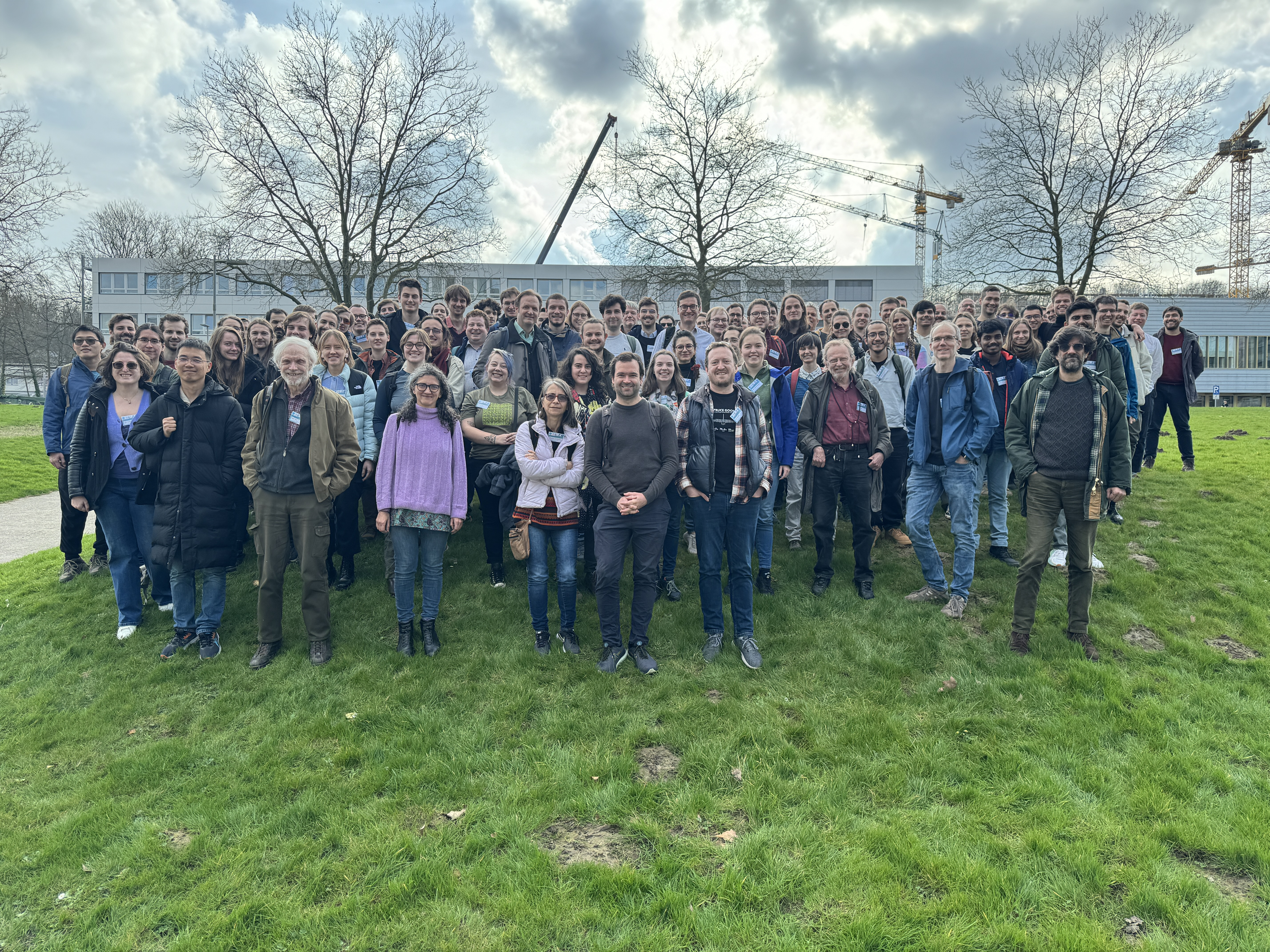
Organisers: Ilaria Castellano, Dawid Kielak and Stefan Witzel.
Registration is closed!
THIS CONFERENCE IS SUPPORTED BY
Funded by the Deutsche Forschungsgemeinschaft (DFG, German Research Foundation) -- SFB-TRR 358/1 2023 -- 491392403
Invited Speakers
- Uri Bader (Weizmann Institute of Science)
- Robert Bieri (Goethe-Universität Frankfurt)
- Yves de Cornulier (CNRS, Nantes Université)
- Alejandra Garrido (Universidad Complutense de Madrid)
- Dessislava Kochloukova (Universidade Estadual de Campinas)
- Claudio Llosa Isenrich (Karlsruher Institut für Technologie)
- Bruno Martelli (Università di Pisa)
- Conchita Martínez Pérez (Universidad de Zaragoza)
- Roman Sauer (Karlsruher Institut für Technologie)
- Anne Thomas (University of Sydney)
- Matthew Zaremsky (University at Albany)
Programme
The conference dinner will be at the Numa.
| Time | Title | Speaker |
|---|---|---|
| Monday, 18.03 | ||
| 09:00 - 10:00 | Registration | |
| 10:00 - 11:00 | Negatively curved spaces obtained via branched coverings over a torus | Bruno Martelli (Università di Pisa) |
| 11:00 - 11:30 | Coffee Break | |
| 11:30 - 12:30 | Groups with exotic finiteness properties from complex Morse theory | Claudio Llosa Isenrich (Karlsruher Institut für Technologie) |
| 12:30 - 14:00 | Lunch | |
| 14:00 - 14:30 | Dehn functions of subgroups of direct products of free groups | Matteo Migliorini (Karlsruher Institut für Technologie) |
| 14:45 - 15:15 | Virtual fibration of trivalent triangle groups acting on hyperbolic buildings | Ana Isakovic (University of Cambridge) |
| 15:15 - 16:00 | Coffee Break | |
| 16:00 - 16:30 | Homological finiteness conditions for totally disconnected locally compact groups. | Sofiya Yatsyna (Royal Holloway University of London) |
| 16:45 - 17:15 | Profinite rigidity and flexibility of Coxeter groups | Olga Varghese (HHU Düsseldorf) |
| Tuesday, 19.03 | ||
| 09:30 - 10:30 | The cohomology of arithmetic groups from a group theorist’s perspective | Roman Sauer (Karlsruher Institut für Technologie) |
| 10:30 - 11:00 | Coffee Break | |
| 11:00 - 12:00 | Lattices in products of rank 1 simple Lie groups | Uri Bader (Weizmann Institute of Science) |
| 12:00 - 14:00 | Lunch | |
| 14:00 - 14:30 | Vanishing of the second $L^p$-cohomology group for most semisimple groups of rank at least 3 | Antonio Lopez Neumann (Mathematical Institute of the Polish Academy of Sciences) |
| 14:45 - 15:15 | Constructing high-dimensional expanders | Inga Valentier-Branth (Ghent University) |
| 15:15 - 16:00 | Informal discussion on children and academia 1 | |
| 16:00 - 16:30 | Compactly-supported classes in the homology of big mapping class groups | Xiaolei Wu (Fudan University) |
| 16:45 - 17:15 | The Farrell--Jones Conjecture and automorphisms of relatively hyperbolic groups | Naomi Andrew (University of Oxford) |
| Wednesday, 20.03 | ||
| 09:30 - 10:30 | On the group of rectangle exchanges | Yves de Cornulier (CNRS, Nantes Université) |
| 10:30 - 11:00 | Coffee Break | |
| 11:00 - 12:00 | Homological properties in group theory | Dessislava Kochloukova (Universidade Estadual de Campinas) |
| 12:00 - 13:30 | Lunch | |
| 13:30 - 14:30 | On the $\Sigma$-Invariants of Discrete Groups in a Nutshell | Robert Bieri (Goethe-Universität Frankfurt) |
| 14:45 - 15:00 | Conference Picture | |
| 15:00 - 18:00 | Hike | |
| 19:00 - 21:00 | Social dinner at "Numa" | |
| Thursday, 21.03 | ||
| 09:30 - 10:30 | The geometry of conjugation in Euclidean isometry groups | Anne Thomas (University of Sydney) |
| 10:30 - 11:00 | Coffee Break | |
| 11:00 - 12:00 | On coherent Artin groups | Conchita Martínez Pérez (Universidad de Zaragoza) |
| 12:00 - 14:00 | Lunch | |
| 14:00 - 14:30 | Automorphism groups of Salvetti complexes | Merlin Incerti-Medici (Universität Wien) |
| 14:45 - 15:15 | Torsion homology growth and cheap rebuilding of inner-amenable groups | Matthias Uschold (University of Regensburg) |
| 15:15 - 16:30 | Informal discussion on children and academia 2 | |
| 16:30 - 17:00 | Profinite properties and Galois cohomology | Giada Serafini (Heinrich Heine Universität) |
| Friday, 22.03 | ||
| 09:30 - 10:00 | Just-infinite groups via iterated semidirect products | Eduard Schesler (FernUniversität Hagen) |
| 10:00 - 10:30 | Coffee Break | |
| 10:30 - 11:30 | Hyperbolic groups satisfy the Boone-Higman conjecture | Matthew Zaremsky (University at Albany) |
Abstracts
Naomi Andrew (University of Oxford)
The Farrell--Jones Conjecture and automorphisms of relatively hyperbolic groups
The Farrell--Jones conjecture predicts that the K-theory of a group ring is isomorphic to a certain equivariant homology theory, and there are also versions for L-theory and Waldhausen's A-theory. In principle, a positive answer for a family of groups allows one to calculate these K-groups, as well as classifying the manifolds admitting a given fundamental group and implying a positive answer to the Borel conjecture. I will discuss recent results with Yassine Guerch and Sam Hughes on extensions of relatively hyperbolic groups, as well as an application to automorphism groups in the one-ended case.Uri Bader (Weizmann Institute of Science)
Lattices in products of rank 1 simple Lie groups
We all know that irreducible lattices in higher rank semisimple Lie groups are rigid in many ways, but in fact, the situation is less understood for products of rank 1 groups, where no factor has property T. Then, some of the results known to hold in general are only conjectured. Many of these conjectures, e.g. character rigidity, IRS rigidity and URS rigidity, will follow from the "spectral gap conjecture" which I intend to explain in my talk. In fact, the aforementioned URS rigidity does follow from a recent result showing that confined subgroups in such lattices are of finite index. This could be seen as evidence supporting the spectral gap conjecture. The talk is based on joint works with Sauer and Gelander-Levit.Robert Bieri (Goethe-Universität Frankfurt)
On the $\Sigma$-Invariants of Discrete Groups in a Nutshell
The geometric invariants $\Sigma^n(G)$ are structures on the boundary at infinity of the Euclidean space $\mathbb R^n=G/[G,G]\otimes\mathbb R$ – later also on the boundary at infinity of proper CAT(0) spaces. $\Sigma^1(G)$ was born around 1980 (joint work with Ralph Strebel on metabelian groups) and later extended (jointly with Walter Neumann) to general groups G. The higher invariants appeared 1986 (joint work with Burkahrdt Renz) … and then I should mention the names and contributions of many Frankfurt students, but that would not fit into the nutshell. The joint work with Ross Geoghegan on the CAT(0) case appeared between 2002 and 2018. My plan is: 1. To mention some of the (mathematical) miracles along the way, in order to explain why I could not avoid following that track of ever further generalizations. 2. To put a focus on the description of $\Sigma^1(G)$ in terms Buseman-character of rooted $\mathbb R$-tree actions. 3. Point out that our CAT(0)-action invariants – e.g. $\Sigma^n(\mathrm{SL}_2(\mathbb Z[1/m]))$ on the hyperbolic plane – are related to investigating groups acting on hyperbolic spaces.Yves de Cornulier (CNRS, Nantes Université)
On the group of rectangle exchanges
(Joint work with Octave Lacourte) The group of interval exchanges consists of piecewise translations of the interval. We consider one higher-dimensional generalization of this group. Namely, define a "rectangle" in dimension d as the image of the standard rectangle $R_d=[0,1[^d$ by a positive diagonal matrix. A rectangle exchange is a permutation of $R_d$ that is piecewise a translation, where pieces consists of rectangles. We obtain that this group is generated by special elements, called "restricted shuffles". As an application, we describe the abelianization of this group (extending the SAF-invariant known in dimension 1) and prove that its derived subgroup is simple.Alejandra Garrido (Universidad Complutense de Madrid)
Simple totally disconnected locally compact full groups
Full groups of homeomorphisms of the Cantor space are a rich source of simple groups. Given the right conditions on the "seed" group, the full group can be given a totally disconnected locally compact topology and it contains a big simple compactly generated subgroup. An example of this is Neretin's group of almost automorphisms of a tree. This construction and the conditions under which it can be fruitfully used has general theoretical consequences for the class of topologically simple, non-discrete, compactly generated, totally disconnected locally compact groups.Merlin Incerti-Medici (Universität Wien)
Automorphism groups of Salvetti complexes
Given the Salvetti complex of a right-angled Artin group, we study the group of its cubical isometries, which frequently forms a non-discrete tdlc group. We present a method to study these groups that is focused on our ability to understand the stabilizer subgroups. We demonstrate the potency of this method by introducing a finite, topologically generating set and, if there is time, discuss an important simple subgroup.Ana Isakovic (University of Cambridge)
Virtual fibration of trivalent triangle groups acting on hyperbolic buildings
A trivalent triangle group is a triangle of groups with the trivial face group and edge groups isomorphic to $\mathbb Z/3\mathbb Z$. In this talk, I will introduce the weighted $L^2$-cohomology of Coxeter groups originally defined by Davis, Dymara, Januszkiewicz and Okun and use it to show virtual fibration and consequently incoherence of certain trivalent triangle groups acting on hyperbolic buildings.Dessislava Kochloukova (Universidade Estadual de Campinas)
Homological properties in group theory
I will talk on recent results with Stefano Vidussi on higher dimensional coherence.Claudio Llosa Isenrich (Karlsruher Institut für Technologie)
Groups with exotic finiteness properties from complex Morse theory
A group is of finiteness type $F_n$, if it is the fundamental group of an aspherical CW-complex with finite n-skeleton. This generalises being finitely generated and being finitely presented, which correspond to the cases $n=1$ and $n=2$. We say that a group has exotic finiteness properties, if it is of type $F_n$ and not $F_{n+1}$ for some $n$. In this talk I will explain how complex Morse theory can be used to construct subgroups of fundamental groups of compact Kähler manifolds with exotic finiteness properties. I will then illustrate this method through concrete applications, such as the positive solution of Brady's question if for every $n$ there is a hyperbolic group with a subgroup of type $F_n$ and not $F_{n+1}$. This talk is based on joint work with Pierre Py.Antonio Lopez Neumann (Mathematical Institute of the Polish Academy of Sciences)
Vanishing of the second $L^p$-cohomology group for most semisimple groups of rank at least 3
$L^p$-cohomology is a quasi-isometry invariant popularized by Gromov. For semisimple groups over local fields, he predicts a classical behaviour (i.e. vanishing for every $p>1$) in degrees below the rank. It was first shown by Pansu that this is true in degree 1 for all higher rank real semisimple groups. We show vanishing of $L^p$-cohomology in degree 2 for most semisimple groups of rank at least 3, for all $p>1$ in the non-Archimedean case and for large $p$ in the real case.Bruno Martelli (Università di Pisa)
Negatively curved spaces obtained via branched coverings over a torus
In his seminal paper on hyperbolic groups Gromov describes an idea to construct a negatively curved space as a cover over a $n$-torus branched along codimension-$2$ subtori. His construction is notoriously flawed if $n>3$ due to the presence of flats. However, we will show how this idea can be adjusted to work in dimension 5, via some appropriate modifications.Conchita Martínez Pérez (Universidad de Zaragoza)
On coherent Artin groups
Droms has shown that a right angled Artin group is coherent if and only if the defining graph is chordal and that that condition is also equivalent to the derived group being free. Thanks to work by Gordon and Wise, there is a characterization available of when an arbitrary Artin group is coherent in terms of the defining graph that generalizes Drom’s. We use this characterization to show that, as in the RAAG case, an Artin group is coherent if and only if the derived subgroup is free and consider other properties of coherent Artin groups.Matteo Migliorini (Karlsruher Institut für Technologie)
Dehn functions of subgroups of direct products of free groups
A problem that attracted a lot of attention is understanding how wild can a subgroup $H < G_1\times\cdots\times G_n$ be, where the $G_i$ are groups in a fixed class, for example free groups. The finiteness properties of $H$ play an important role: by a result of Bridson, Howie, Miller, and Short, if the $G_i$ are free (or surface) groups and $H$ is of type $\mathcal F_n$, then $H$ must be virtually a direct product itself. If we lower our requirement on $H$ to $\mathcal F_{n−1}$ we obtain examples like the Stallings-Bieri groups $SB_n$, arising as a kernel of $F_2\times\cdots\times F_2\to \mathbb Z$. By a result of Kuckuck, all such $H$ arise virtually as a kernel of a map to $\mathbb Z^r$. We therefore turn our attention to the groups defined as a kernel of a map $F_2\times\cdots\times F_2\to \mathbb Z^r$. We show that there is a uniform polynomial bound on the Dehn function of these groups, answering a question of Dison. This is joint work with Ascari, Bertolotti, Italiano and Llosa Isenrich.Roman Sauer (Karlsruher Institut für Technologie)
The cohomology of arithmetic groups from a group theorist’s perspective
We review some classical results of Borel, Blasius, Grunewald, Franke about the cohomology of arithmetic groups. We reprove and generalise these results using new methods pertaining to geometric group theory and results about spectral gap of unitary representations. This is based on joint work with Uri Bader.Eduard Schesler (FernUniversität Hagen)
Just-infinite groups via iterated semidirect products
An infinite group $G$ is called just-infinite if all of its proper quotients are finite. Since its introduction by McCarthy in the late 1960's, the class of just-infinite groups received a lot of attention. One reason for the importance of just-infinite groups is that, by Zorn's lemma, every finitely generated, infinite group admits a just-infinite quotient. By a celebrated result of Wilson, the study of just-infinite groups can be reduced to the study of simple groups, branch groups, and hereditarily just-infinite groups, i.e. groups all of whose finite index subgroups are just-infinite. After recalling some background on residually finite groups and profinite completions, I will present an elementary idea that gives rise to constructions of all 3 types of just-infinite groups. As an application, we will discuss the first examples of finitely generated just-infinite groups that are residually finite and have positive rank gradient. In fact we will see that these examples have positive first $L^2$-Betti-number. This talk is based on joint work with Steffen Kionke.Giada Serafini (Heinrich Heine Universität)
Profinite properties and Galois cohomology
The first $\ell^2$-Betti number is a profinite invariant for finitely presented, residually finite groups but this does not hold true anymore if we pass to higher degrees, as exhibited by S-arithmetic groups. Nevertheless, some interesting information on the $\ell^2$-cohomology of S-arithmetic groups still seems to be preserved under profinite commensurability. In my talk, I am going to report on work in progress how to conclude this and possibly more such phenomena from local global principles in Galois cohomology.Anne Thomas (University of Sydney)
The geometry of conjugation in Euclidean isometry groups
We give a simple and beautiful description of the geometry of conjugation within any split subgroup $H$ of the full isometry group $G$ of Euclidean space. We prove that for any $h \in H$, the conjugacy class $[h]$ is described geometrically by the move-set of its linearisation, while the set of elements conjugating $h$ to a given $h' \in [h]$ is described by the fix-set of its linearisation. Examples include affine Coxeter groups, where we are able to give finer results in all types, certain other crystallographic groups, and the group $G$ itself. This is joint work with Elizabeth Mili\'cevi\'c and Petra Schwer.Matthias Uschold (University of Regensburg)
Torsion homology growth and cheap rebuilding of inner-amenable groups
Inner-amenability is a weak form of amenability, which is satisfied e.g. by products where one factor is infinite amenable. Some properties of amenable groups extend to inner-amenable groups, e.g. the vanishing of the first $\ell^2$-Betti number. In this talk, we will treat logarithmic torsion homology growth. One tool for showing vanishing of this invariant is the cheap rebuilding property of Abért, Bergeron, Frączyk and Gaboriau. Certain inner-amenable groups have this property in degree one, thus extending vanishing results that were already known for amenable groups.Inga Valentier-Branth (Ghent University)
Constructing high-dimensional expanders
High-dimensional expanders are a generalization of the notion of expander graphs to simplicial complexes and give rise to a variety of applications in computer science and other fields. We construct new high-dimensional expanders from quotients of certain Kac-Moody-Steinberg groups, using their rich structure. These groups are developments of complexes of groups related to groups of Lie type and their generalizations. In this talk, I will introduce the concepts of spectral and topological high-dimensional expansion and I will present our construction of spectral expanders. The talk is based on a joint work with L. Grave de Peralta.Olga Varghese (HHU Düsseldorf)
Profinite rigidity and flexibility of Coxeter groups
For a group $G$ we denote by $F(G)$ the set of isomorphism classes of finite quotients of $G$. We address the following question: Let $W$ be a Coxeter group. Given a finitely generated residually finite group $G$ with $F(G)=F(W)$, what can be said about $G$?Xiaolei Wu (Fudan University)
Compactly-supported classes in the homology of big mapping class groups
I will start the talk with an overview about the theory of big mapping class groups. Then I will discuss some recent advances on the homology of big mapping class groups. In particular, I want to talk about some of my recent work with Martin Palmer on when the homology of the big mapping class groups could have elements with compact support.Sofiya Yatsyna (Royal Holloway University of London)
Homological finiteness conditions for totally disconnected locally compact groups.
In 1987, Gedrich and Gruenberg introduced invariants of a ring: $\textit{silp}~R$, the supremum of the injective lengths of the projectives, and $\textit{spli}~R$, the supremum of the projective lengths of the injectives. Particularly, they showed that given a suitable commutative ring $K$ and group $G$, if $\textit{spli}~KG$ is finite, then $\textit{silp}~KG$ is also finite. In this talk, I will discuss ongoing research that aims to extend this result through the utilisation of rational discrete cohomology. Specifically, I will explore the development of an analogous theory for these invariants within the context of totally disconnected locally compact groups -- topological groups characterized by the property that every neighbourhood of the identity includes a compact open subgroup.Matthew Zaremsky (University at Albany)
Hyperbolic groups satisfy the Boone-Higman conjecture
The 1973 Boone-Higman Conjecture predicts that every finitely generated group with solvable word problem embeds in a finitely presented simple group. In joint work with Jim Belk, Collin Bleak, and Francesco Matucci, we prove that all hyperbolic groups satisfy the Boone-Higman Conjecture, that is, every hyperbolic group embeds into some finitely presented simple group. This shows that the conjecture holds in the "generic" case for finitely presented groups. Our key tool is a new family of groups, which we call rational similarity groups (RSGs), that is interesting in its own right. We prove that every hyperbolic group embeds in a full, contracting RSG, and every full, contracting RSG embeds in a finitely presented simple group, thus establishing the result.Participants
- Abels, Herbert (Bielefeld University)
- Abgrall, Adrien (Université de Rennes)
- Andrew, Naomi (University of Oxford)
- Arenas, Macarena (University of Cambridge)
- Ascari, Dario (University of the Basque Country)
- Assy, Lyn (Ludwig Maximilian Universität)
- Bader, Shaked (University of Oxford)
- Bertolotti, Federica (Scuola Normale Superiore)
- Bogliolo, Elena (University of Pisa)
- Bradford, Henry (University of Cambridge)
- Bravo, Claudio (Ecole Polytechnique)
- Brück, Benjamin (Universität Münster)
- Busch, Sira (University of Münster)
- Bux, Kai-Uwe (Bielefeld University)
- Campagnolo, Caterina (Universidad Autónoma de Madrid)
- Capovilla, Pietro (SNS Pisa)
- Castellano, Ilaria (Bielefeld University)
- Chanfi, Dorian (JLU Gießen)
- chemikh, smail (USTHB Alger)
- Cohen, William (University of Cambridge )
- Conte, Martina (Heinrich-Heine-Universität Düsseldorf)
- Deré, Jonas (KU Leuven Kulak)
- Echtler, Daniel (Heinrich Heine University Düsseldorf)
- Embleton, Alexandra (Royal Holloway, University of London)
- Feuerpfeil, Julian (Università degli Studi di Milano-Bicocca)
- Fisher, Sam (University of Oxford)
- Fournier-Facio, Francesco (University of Cambridge)
- Francoeur, Dominik (Newcastle University)
- Fruchter, Jonathan (University of Bonn)
- García Mejía , Jerónimo (Karlsruhe Institut für Technologie )
- Hadziosmanovic, Ervin (SNS Pisa)
- Hartmann, Elisa (Bielefeld University)
- Heller, Julia (KIT Karlsruhe)
- Herron, Amy (University at Buffalo)
- Hofmann, Franziska (Universität Regensburg)
- Holm, Kristian (CAU Kiel)
- Hsueh, Chun-Sheng (Humboldt-Universität zu Berlin)
- Hughes, Sam (University of Oxford)
- Isakovic, Ana (University of Cambridge)
- Kammeyer, Holger (Heinrich Heine University Düsseldorf)
- Kelln, Colby (Cornell University )
- Kielak, Dawid (University of Oxford)
- King, Simon Alexander (Friedrich-Schiller-Universität Jena)
- Kionke, Steffen (FernUniversität in Hagen)
- Klinge, Kevin (Karlsruhe Institute of Technology)
- Kochloukova, Dessislava (Unicamp)
- Lederle, Waltraud (TU Dresden)
- Li, Kevin (Universität Regensburg)
- Li, Qing (shijiazhuang traditional chinese )
- Long, Yusen (Institut de Mathématiques d'Orsay)
- López Neumann, Antonio (Mathematical Institute of the Polish Academy of Sciences)
- Loué, Alex (Université Catholique de Louvain)
- Mandal, Manas (The Institute of Mathematical Sciences (IMSc))
- Marchand, Alexis (University of Cambridge)
- Marchionna, Bianca (Bielefeld University and University of Milano-Bicocca)
- Marmo, Ettore (Università degli Studi di Milano-Bicocca)
- Migliorini, Matteo (Karlsruher Institut für Technologie)
- Mineh, Lawk (University of Southampton)
- Molyneux, Lewis (Royal Holloway, University of London)
- Morales, Ismael (University of Oxford)
- Mouadi, Hassan (Ibnou Zohr University , Polydisciplinary Faculty of Taroudant)
- Munro, Zachary (McGill)
- Ng, Andrew (University of Bonn)
- Palmer, Marcel (Universität Bielefeld)
- Parackal, Romeo (Cochin University of Science and Technology, India)
- Patil, Harsh (University of Bristol )
- Petschick, Jan Moritz (Universität Bielefeld)
- Price, Amethyst (University of California Santa Cruz)
- Quintanilha, José Pedro (Universität Heidelberg)
- Rajabova, Nilufar (Karlsruhe Institute of Technology )
- Reyes, Eduardo (MPIM Bonn)
- Rudd, Cameron (Max-Planck-Insitute Bonn)
- Rusakov, Illja (Universität Regensburg)
- Sánchez-Peralta, Pablo (Universidad Autónoma de Madrid)
- Santos Rego, Yuri (University of Lincoln)
- Schesler, Eduard (FernUniversität Hagen)
- Schillewaert, Jeroen (University of Auckland)
- Schneider, Paul Hannes (Bielefeld University)
- Serafini, Giada (Heinrich Heine Universitat )
- Singh, Gurnoor (Cheentan)
- Sliazkaite, Ruta (University of Warwick)
- Soifer, Gregory (Bar-Ilan University)
- Striftaris Chalkiopoulos, Aristodimos (Ludwig-Maximilians-Universität München)
- Sun, Bin (Michigan State University)
- Święcicki, Krzysztof (Wrocław University of Science and Technology)
- TEJBIR, TEJBIR (IISER Mohali, India)
- Theiß, Niklas (JLU Gießen)
- Thiesen, Nils (CAU Kiel)
- Thilmany, François (UC Louvain)
- Titz Mite, Thomas (JLU Gießen)
- Uschold, Matthias (University of Regensburg)
- Valentiner-Branth, Inga (Ghent University)
- Vankov, Vladimir (University of Bristol)
- Varghese, Olga (HHU Düsseldorf)
- Vock, Christian (CAU Kiel)
- Waite, Luke (University of Southampton)
- Weidmann, Richard (CAU Kiel)
- Weigel, Thomas (University of Milano-Bicocca)
- Weis, Jannis (Karlsruher Institut für Technologie)
- Witzel, Stefan (JLU Gießen)
- Wu, Xiaolei (Fudan University)
- Wykowski, Julian (University of Cambridge)
- Yatsyna, Sofiya (Royal Holloway, University of London)
- Zellhofer, Paul (CAU Kiel)
- Zhao, Cunyuan (EPFL)
